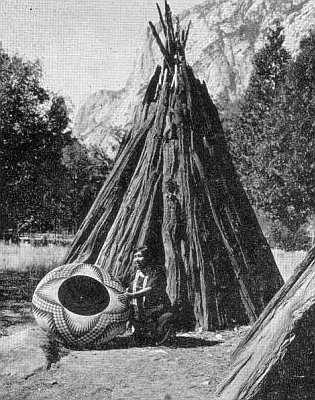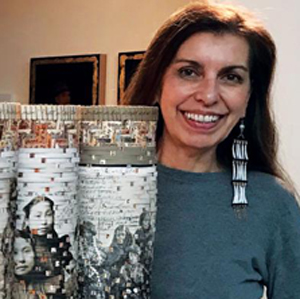Related Research Articles

Basket weaving is the process of weaving or sewing pliable materials into three-dimensional artifacts, such as baskets, mats, mesh bags or even furniture. Craftspeople and artists specialized in making baskets may be known as basket makers and basket weavers. Basket weaving is also a rural craft.

Mike Dart is a Native American basket weaver and citizen of the Cherokee Nation, who lives in Oklahoma.
Kay WalkingStick is a Native American landscape artist and a member of the Cherokee Nation. Her later landscape paintings, executed in oil paint on wood panels often include patterns based on Southwest American Indian rugs, pottery, and other artworks.

Mavis Doering was a Cherokee Nation basketmaker from Oklahoma.

Martha Berry is a Cherokee beadwork artist, who has been highly influential in reviving traditional Cherokee and Southeastern beadwork, particularly techniques from the pre-Removal period. She has been recognized as a Cherokee National Treasure and is the recipient of the Seven Star Award and the Tradition Bearer Award. Her work is shown in museums around the United States.

Kelly Jean Church is a black ash basket maker, Woodlands style painter, birchbark biter, and educator.
Sharon Irla is a Cherokee artist, enrolled in the Cherokee Nation. A self-taught artist, Irla began entering competitive art shows in 2003. Her collective body of works span the fields of painting, murals, graphics, photography, and custom picture frames with Southeastern Woodlands / Mississippian motifs. The majority of her awarded works are oil-on-canvas portraits of Cherokee women in both contemporary and historical settings.
Native American women in the arts are women who are from Indigenous peoples from what is now the mainland United States who are visual art professionals. Women in Native American communities have been producing art intertwined with spirituality, life, and beauty for centuries. Women have worked to produce traditional art, passing these crafts down generation by generation, as well as contemporary art in the form of photography, printmaking, and performance art.

Shan Goshorn was an Eastern Band Cherokee artist, who lived in Tulsa, Oklahoma. Her interdisciplinary artwork expresses human rights issues, especially those that affect Native American people today. Goshorn used different media to convey her message, including woven paper baskets, silversmithing, painting, and photography. She is best known for her baskets with Cherokee designs woven with archival paper reproductions of documents, maps, treaties, photographs and other materials that convey both the challenges and triumphs that Native Americans have experienced in the past and are still experiencing today.
Dana Tiger is a Muscogee artist of Seminole and Cherokee descent from Oklahoma. Her artwork focuses on portrayals of strong women. She uses art as a medium for activism and raising awareness. Tiger was inducted into the Oklahoma Women's Hall of Fame in 2001.

Jane Osti is a native Cherokee artist. She specializes in traditional Cherokee pottery with unique embellishments and designs. In 2005, Osti was one of the youngest Cherokee artists to be appointed as a Living Treasure by Cherokee Nation. Currently, Osti teaches and creates her own pottery in her studio in downtown Tahlequah.
Mel Cornshucker is a contemporary Cherokee potter living in Tulsa, Oklahoma, who works in stoneware, porcelain, and raku clay. Cornshucker is known for his high-fire stoneware, decorated with hand-painted, Native-inspired motifs and designs.
Eva Wolfe was an accomplished basket maker from North Carolina. Wolfe was known for weaving rivercane baskets, a traditional type of Cherokee basketry. She earned special distinction for her accomplishments in doubleweave basketry, a difficult plaited basket weaving technique. She was honored with a number of awards for her achievements as an artist, including the Brown-Hudson Folklore Award from the North Carolina Folklore Society in 1988 and the North Carolina Heritage Award in 1989.

Lottie Queen Stamper was an Eastern Band Cherokee basket maker and educator.
Jeanne Rorex-Bridges is painter and illustrator based in Oklahoma. She is a member of the Echota Cherokee Tribe of Alabama, a state-recognized tribe.
Mary Adair is a Cherokee Nation educator and painter based in Oklahoma.

Anna Mitchell was a Cherokee Nation potter who revived the historic art of Southeastern Woodlands pottery for Cherokee people in Oklahoma. Her tribe designated her as a Cherokee National Treasure and has works in numerous museum collections including the Smithsonian National Museum of the American Indian, the Museum of Fine Arts, Boston, and the Fred Jones Jr. Museum of Art, among others.

Mary Holiday Black was a Navajo basket maker and textile weaver from Halchita, Utah. During the 1970s, in response to a long-term decline in Navajo basketry, Black played a key role in the revival of Navajo basket weaving by experimenting with new designs and techniques, pioneering a new style of Navajo baskets known as "story baskets."
Bill Glass Jr. is a Cherokee Nation ceramic artist, sculptor, and public artist, who was named a Cherokee National Treasure in 2009.

Lena Frank Dick was a Washoe basket maker best known for her tight weaves and figurative designs. Her baskets were primarily aesthetic as opposed to utilitarian.
References
- 1 2 3 4 Pearson-Little Thunder, Julie (January 25, 2013). "Oral History Interview with Lena Blackbird". Oklahoma Native Artist. Retrieved 29 July 2020.
- 1 2 3 Conley, Robert (2007). A Cherokee Encyclopedia. University of New Mexico Press. ISBN 978-0-8263-3951-5.
- ↑ Power, Susan (2007). Art of the Cherokee: Prehistory to the Present. University of Georgia Press. ISBN 978-0-8203-2767-9.
- ↑ Duvall, Deborah (1999). The Cherokee Nation and Tahlequah. Charleston, South Carolina: Arcadia Publishing. ISBN 978-0-7385-0289-2.
- ↑ "Cherokee Homecoming Art Show Winners Announced". Native American Times. November 1, 2001.
- ↑ Snell, Travis (January 31, 2002). "Cherokee Medals of Honor". Cherokee Phoenix.
- ↑ "Cherokee Homecoming Art Show winners announced". Cherokee Phoenix. November 10, 2004.